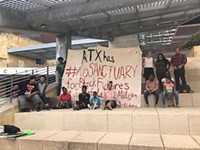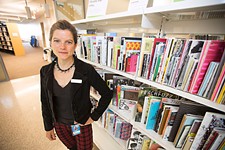The Once and Future Library
A new Central Library rises in the transformational middle of Downtown
By Michael King, Fri., Oct. 30, 2015

"We are trying to create an iconic landmark that is a tribute to the love of knowledge that this community has ... a building that they can be proud of, and that they can feel at home in." In an early October conversation, Austin Public Library Director Brenda Branch was summarizing the goal that planners were maintaining as they spent the last several years conceptualizing what will become the new Central Library, under construction above Shoal Creek, on West Cesar Chavez Street, and scheduled to open in the fall of 2016. Although the work is proceeding rapidly and the exterior is taking shape, the six main floors remain in preliminary stages, the skeleton of a building that promises a myriad of features both traditional and innovative: reading rooms and performance spaces, general and specialized collections and an "innovation lab," an art gallery and a demo kitchen, and areas discretely designed to attract children, teens, and adults.
Walking through the active construction with Library Director Brenda Branch and Facilities Process Manager John Gillum, it's easy to catch the enthusiasm they have for a project many years in the making. The initial bond funding of $90 million for construction was approved by voters in 2006, with additional city funding from various sources eventually bringing the overall project cost (including planning, architecture, engineering, and prospective technology) to about $120 million. The architectural team of Lake/Flato Architects and Shepley Bulfinch was selected in 2008; groundbreaking finally occurred in 2013, and the project is now well on its way to completion next summer. Yet, that's a foreshortened timeline: The John Henry Faulk Central Library, opened in 1979, was already too small and overburdened after a decade, and there was talk of a library bond in 1992 and again in 1996, Gillum recalls. "We finally clicked for the 2006 bond."
What most differentiates the new building from John Henry Faulk, Branch says, are the "special gathering places." "What we want is to make this a gathering place for the Austin community," she continues, and Gillum adds, "There's like 12 meeting rooms of various sizes; we call them 'shared learning rooms.'" Those are conspicuous by their absence in the Faulk building, which will, however, eventually become expansion space for the almost comically overcrowded Austin History Center – built in 1933 at Ninth and Guadalupe, the AHC became the second city library, and maintained that status for nearly 50 years. Conscious of that time span, Branch and Gillum say they have tried mightily to imagine a building that needs to last, and be adaptable to new uses, for at least 50 years ... or longer.
"We want this library to last," said Gillum. "We're building a 100-year building. We're still taking care of the History Center – it was built in '33. Nobody builds like that – nobody builds for the ages anymore, but we do. In 100 years from now, I hope that [the new library] building is serving the Austin community."

Staying Flexible
In addition to its commitment to community gathering spaces, the new building reflects the planners' commitment to another fundamental principle: "flexibility." "We know what it's like to build a building that didn't foresee the future very well," said Gillum, "because we have [John Henry Faulk, which opened in 1979]. They didn't know about computers then, and they didn't see it coming."
As it has nearly everything else, the digital era has altered the shapes and functions of libraries everywhere, and Branch and Gillum (who have worked together long enough that they finish each other's thoughts and sentences) have studied well the last couple of decades in conceiving the new library. "We realized we needed to do something different than people had done in the past," Gillum said. "There was a renaissance of new central libraries that had started about 1995, so we had a lot of buildings to look at and learn from." Among the libraries and cities they visited and learned from (physically or online) were Phoenix, Seattle, San Antonio, Amsterdam, Nashville ... The list goes on, and continues – Berlin librarians, now planning their own new central library, check in with Branch and Gillum on what's working, and what isn't.
They say the first thing they learned, in conceiving the space, was not to get ahead of themselves or try to "predict the future." "We started out thinking, What's going to happen 25 years out? – and gave that up immediately – let's start shooting for 10, maybe five," says Gillum. Rather than outguess the public and the technology, the goal became to imagine adaptable, multipurpose spaces, including places that would allow for the best possible storage of library materials.
"We didn't know at the time that we started this building whether books or electronic media was going to be the big thing," Branch says. "So many of our shelves are on coasters, so if in the future – it's not the case now, we're going to have more books in that building than we do [now] – but if in the future, electronic materials take off, and books diminish somehow, then we just move those shelves off. I don't predict that to happen anytime soon; that's not been our experience here."
They credit their visit to Amsterdam and the help of California librarian and "library futurist" Joan Frye Williams for inspiring their approach to the overall design of the building. "We wanted the library of the future," Branch continues. "We wanted to be sure we could make this building as adaptable as possible, so we could maximize the space, because we had limited resources. [Williams] came in and just blew us away. She gave us our building program. She basically showed us how to make this building so that every area of the building has multiple uses, so that the spaces are adaptable."

Williams consulted primarily in the early planning stages of 2008 (Branch: "She came in and blew us away"; Gillum: "She kicked it up another notch") and says that library "futuring" is not prediction or forecasting, but "imagining a range of situations ... any one of which might come true, and all might be possible." Since libraries characteristically don't have the budgets to do their own research and development, she says she draws from other disciplines – retail, medicine, even gaming – and tries to "translate that knowledge into library practice."
"I looked at [APL's] current operations, and looked for the challenges they're facing that could be opportunities." Her recommendations, she said, were often simply pragmatic – for example, not to build in "permanent features like monumental service desks, when we know that's going to change," but also "to recognize very consistent human behaviors – that we know, for example, that high daylight works well for making human beings feel inspired." Hence the library's windows in all directions, and the indoor-outdoor spaces to enable both private reading and research, and community engagement. It was Williams who suggested the Openbare Bibliotheek Amsterdam, an immediate predecessor, as the best current model of where libraries are headed – Branch and Gillum report that City Manager Marc Ott told them, "Then you need to go to Amsterdam." Williams – and Amsterdam – gave them the blank planning slate and the host of inspiring ideas they needed. "Don't do a lot of built-ins," Williams advised. "Put your money into flexibility."
The librarians' enthusiasm about their consultant's input is echoed in Williams' recollection, on the phone from Sacramento. "Austin is the kind of place where people get together with a lot of energy," she said, "and do amazing things. They're not just throwing money at [the library] but reaching out to engage the community. It's such a pleasure to get a client who wants to do something and wants to run with it."

The More Things Change
Of course, when most people think "libraries," the first image is of row after row of shelving filled with books. Branch is quick to respond, "We still will have books ... and that's based on the fact that the demand for books has not diminished. ... In our [user] statistics, our circulation of the hardcover books has not decreased. Now, in one year [2015 over 2014], circulation of electronic materials has increased by 38 percent – but the same people who are checking out electronic [materials] are also checking out hardcover books." ("We like our information in a lot of formats," adds Gillum.)
Branch emphasizes that the traditional functions of the library remain in the new context, and indeed the space will be designed to better support those functions than in the cramped confines of the current Central Library. "We're still there for the families, the story times; we're still there for the kids who need to come in and do their assignments, we're still there for the browsers who want to come in and see what's new and check it out." She points to research surveys that confirm readers may determine online what materials are available, but they come to the library not only to retrieve (or perhaps use via in-library computers) those materials – but to browse the displays and shelves. "The reason people come to the library, according to surveys, is to browse – to look at the shelves, look at the books, pick up something, read a blurb, leaf through it, and then check something out, digitally or hard copy."

Branch notes that the library's technology functions ("what were Library Schools are now called Information Schools") now extend to bridging the "digital divide" – that is, providing computer learning (and public hardware) to citizens who otherwise would not have access. "We all take that very seriously," Branch said. "There are people who would not have the information they need to be a functioning member of society if they don't have those skills, and we give them that. We give them the computers they don't have, we give them the training, and classes, we have two computer job centers, we have staff members who do nothing all day except help people learn how to get on a computer, how to use a mouse, how to create an email account, and help them find jobs. That's something when I started being a librarian, 50 years ago [Branch has been director of APL for 24 years], I didn't realize was going to be such a big part of a library."
People who have rather less experience of contemporary libraries sometimes argue that they have been superseded by technology – that everything the library contains is accessible online, or even on smartphones. Librarians roll their eyes at such statements, beginning with the notion that "everything's available online." Williams, Branch, and Gillum all note that "everything's not available online," and certainly "everything's not accessible online."
Mark Smith, director of the State Library of Texas, has a similar response, from a larger perspective. "I hear these comments (though frankly less often than we did a few years ago) and I have to assume that these are people that haven't actually been in a library recently. If they had, they would have seen an environment where the public is interacting with one another and information resources in a multitude of ways that are simply not replicable on a handheld device or personal computer. Even if it were true that all information is available online – which is a fallacy – many members of the public rely on the library for their technology access. And far beyond just the question of information access, libraries provide a framework for lifelong learning that creates stronger, more resilient communities."
So via the socially binding aspect of computer technology, we return to the library as a community gathering place. Branch and Gillum point to the spaces designed to bring children together, to bring adults together, techies and teenagers (who they say have been woefully neglected in recent years). Williams argues that while at times we may read or work privately, we also yearn for and benefit from community. "Social activities, the events of the day, coaching – those activities you don't get online in the same way, as when you're part of a community. ... Learning and thinking and reading and embracing the culture are well done in community, and not just alone in your house."

Branch and Gillum say that the spirit of the Austin community has been well reflected in the support the project has received at City Hall, from the city councils that approved and supported the bond and the financing, to the voters who endorsed the bonds (and subsequent bonds devoted to improving the library branches) to the city administrators who have encouraged and approved their work. "They basically told us to dream big and to deliver something that the city of Austin and the whole community could be very proud of," Branch said. "So that's what we've tried to do. We don't want to cut corners. We want to build a world-class library that this world-class city will be proud of."
Whatever second-guessing might have occurred over the years about cost or location or details, Branch and Gillum exude an optimism about the present and future of libraries – and about the particular Central Library steadily rising to take its place in the Downtown skyline – that is cheerfully contagious. Branch sums up her anticipation of next November's grand opening: "I am confident that when this building opens, the entire community is going to be happy with it, and celebrate it."
Got something to say on the subject? Send a letter to the editor.











